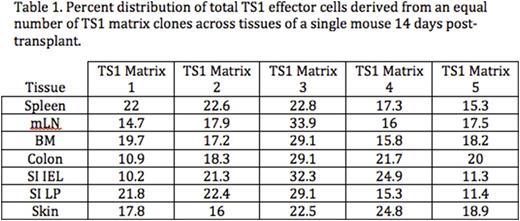Abstract
In graft-versus-host disease (GVHD) donor αβ T cells in the allograft recognize host tissues as non-self and cause multi-organ damage through direct and indirect mechanisms. This multi-organ disease is mediated by T cells acquiring diverse phenotypes, including expression of homing receptors, adhesion molecules, cytokines and other effector molecules. How this diversity is generated at a clonal level is not understood. In the one extreme, each type of effector could be derived from a single T cell expressing a unique antigen receptor that may even target a unique antigen. Alternatively, a single T cell targeting a single antigen may be able to differentiate into a variety of effectors (Fig. 1). A second related question is whether GVHD is maintained within affected organs. That is, what is the importance of the continued recruitment of new blood-derived alloreactive effectors in maintaining GVHD.
To answer these questions, we needed 1) a system in which GVHD-inducing T cells could be unambiguously tracked, as in polyclonal systems it is difficult if not impossible to know which T cells are disease causing; and 2) a way to distinguish GVHD-inducing T cells at the clonal level. To address the first point, we used a CD4 T cell receptor (TCR) transgenic (Tg) model of GVHD wherein GVHD is induced by the transfer of <1000 BALB/c RAG2-/- TS1 TCR Tg T cells, which recognize the S1 peptide derived from HA, into BALB/c RAG2-/- HA104 Tg recipients that ubiquitously express HA. GVHD is manifest by weight loss, death, and TS1-infiltrative pathology of the skin, liver, small intestine and colon. In order to determine the clonal contributions, we crossed TS1 Tg mice to combinations of CD45.1, CD45.2, Thy1.1, Thy1.2 and GFP backgrounds to create a matrix of up to 9 distinguishable TS1 cells.
Using this model, we first characterized the variety of TS1 effector phenotypes being generated across tissues at day 14 and 21 post-transplant and will be presenting data detailing these TS1 phenotypes, including the expression of CCR9, α4β7 integrin, and cutaneous lymphocyte antigen (CLA).
To confirm that different matrix cells perform similarly, we assessed the development of total TS1 effector cells in mice that had received an equal number of 5 distinct TS1 cell combinations. We found that within individual mice (n=5), there is comparable distribution of GVHD-causing TS1 effector cells (% of total TS1 cells) from all 5 TS1cell matrices across tissues 14-21 days post-transplant (Table 1).
We next tested our ability to detect total effector cells derived from transferring low numbers of TS1 cells (5-500 cells) of a given matrix combination. We found that within individual mice (n=9), the transfer of 5 and 10 TS1 clones of a given matrix results in disparate distribution of TS1 effectors (% of total TS1 cells) across tissues 14-21 days post-transplant. As an example for one mouse at day 14, the fraction of TS1effectors derived from 10 TS1clones of one matrix was 0.8% (spleen), 1.9% (mLN), 1.4% (BM), 0.6% (colon), 4.4% (SI IEL), 1.1% (SI LP), 1.2% (skin) and 1.5% (liver). In that same mouse, the fraction of TS1effectors derived from 5 TS1clones of a different matrix was 0.7% (spleen), 0.9% (mLN), 0.4% (BM), 1.1% (colon), 1.1% (SI IEL), 0.6% (SI LP), 0.6% (skin) and 2.7% (liver). We made similar observations in mice at day 21, where the percentage of TS1 effectors derived from 5 TS1 clones in one mouse was 2.5% (spleen), 2.0% (BM), 2.8% (mLN), 0.2% (SI IEL), 2.3% (SI LP), 1.1% (skin) and 1.6% (liver). When focusing on specific TS1 phenotypes derived from 5 and 10 TS1clones, we also found unequal distributions of these cells across different tissues. For example, the distribution of CD69+CD103+ TS1 cells (% of total TS1 cells) derived from 5 TS1clones was 2.9% (colon), 1.5% (SI IEL) and 1.9% (SI LP) in one mouse at day 14. Similarly, TS1 cells expressing α4β7 integrin also varied in distribution across tissues, with one mouse having 2.2% (spleen), 0.5% (mLN) and 0% (BM) α4β7+ TS1 cells. These data suggest that tissue GVHD effectors are not simply in equilibrium with blood, consistent with some local GVHD maintenance. Furthermore, the presence of 5 TS1 clones in more than one effector type suggests that single cells can differentiate into multiple effectors. We are now directly addressing these possibilities by analyzing progeny derived from many sorted single cells.
No relevant conflicts of interest to declare.
Author notes
Asterisk with author names denotes non-ASH members.



This feature is available to Subscribers Only
Sign In or Create an Account Close Modal